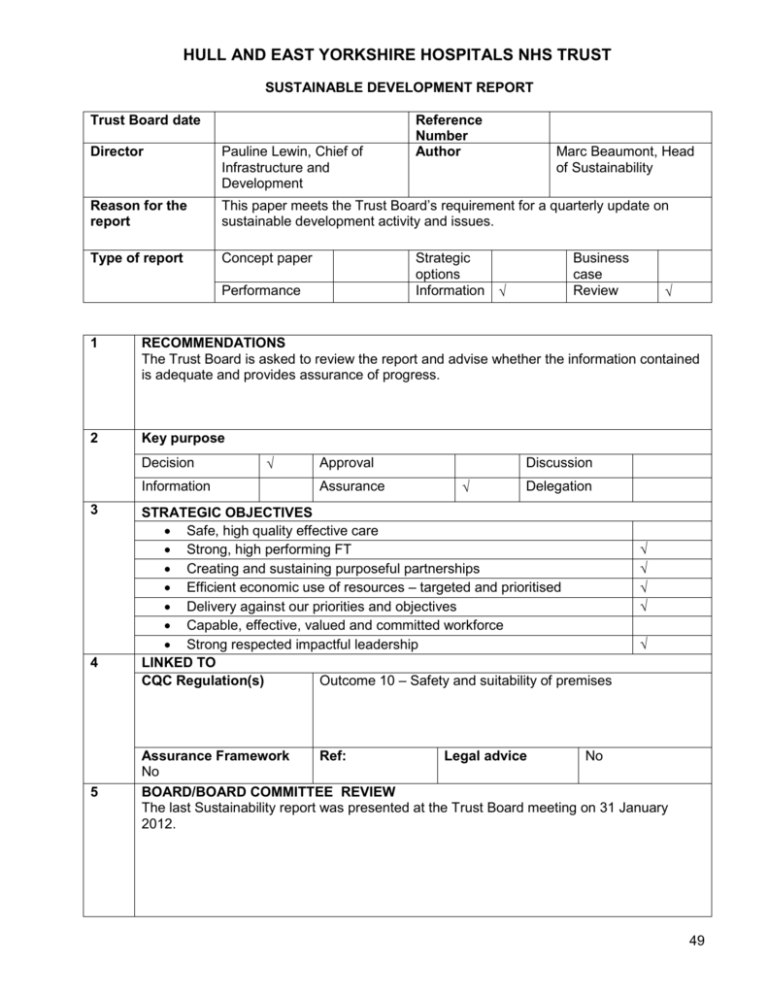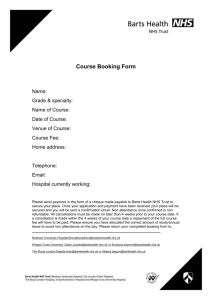Sustainability - Hull and East Yorkshire Hospitals NHS Trust
advertisement

HULL AND EAST YORKSHIRE HOSPITALS NHS TRUST SUSTAINABLE DEVELOPMENT REPORT Trust Board date Reference Number Author Director Pauline Lewin, Chief of Infrastructure and Development Reason for the report This paper meets the Trust Board’s requirement for a quarterly update on sustainable development activity and issues. Type of report Concept paper Strategic options Information Performance Marc Beaumont, Head of Sustainability Business case Review 1 RECOMMENDATIONS The Trust Board is asked to review the report and advise whether the information contained is adequate and provides assurance of progress. 2 Key purpose Decision Information 3 4 5 Approval Assurance Discussion Delegation STRATEGIC OBJECTIVES Safe, high quality effective care Strong, high performing FT Creating and sustaining purposeful partnerships Efficient economic use of resources – targeted and prioritised effectively Delivery against our priorities and objectives Capable, effective, valued and committed workforce Strong respected impactful leadership LINKED TO CQC Regulation(s) Outcome 10 – Safety and suitability of premises Assurance Framework Ref: Legal advice No No BOARD/BOARD COMMITTEE REVIEW The last Sustainability report was presented at the Trust Board meeting on 31 January 2012. 49 HULL AND EAST YORKSHIRE HOSPITALS NHS TRUST SUSTAINABLE DEVELOPMENT REPORT – SEPTEMBER 2012 1. PURPOSE OF PAPER This paper fulfils the Trust Board’s request to receive regular updates on sustainability activity and issues. 2. CARBON REDUCTION 2.1 Carbon Emissions and Energy Performance The chart below gives the Trust’s CO2 emissions from April 2008 to June 2012. Hull and East Yorkshire Hospitals NHS Trust CO2 Emissions April 2008 to June 2013 3400 3200 tonnes CO2 3000 2800 2600 2400 2012/13 2011/12 2010/11 2009/10 2008/09 2200 2000 apr may jun jul aug sep oct nov dec jan feb mar CO2 emissions continue to track around or below previous years’ consumption, excluding the exceptional return for May 2011. The predicted cost of the new CRC Scheme to the Trust was slightly less for 2011/12 than anticipated, at £285k. Validation of the Trust’s processes is being undertaken by the Internal Audit team. The Trust achieved compliance for 2011/12 under the European Union Emissions Trading System (EUETS) by submitting the annual return of emissions management, with external verification. The Trust has registered its interest in the opportunity to opt out of the main EUETS scheme in 2013, under the ‘hospitals and small emitters’ clause. This would reduce the financial and administrative burden but the Trust would still be committed to reducing CO2 emissions in line with revised targets. 50 The Department of Health has declared that is now mandatory that all NHS Trusts report on sustainability as part of their annual reporting process. The NHS Sustainable Development Unit and DH developed a template framework of data for inclusion, which has been used as the basis of the Sustainability section of this year’s Annual Report & Accounts. The main points of note are the 8% reduction in energy consumption (but with a 7.6% increase in costs due to energy prices), the reduction in carbon emissions of 1,755 tonnes and that the trust recycles 47% of its waste. 2.2 Carbon Reduction Projects Improvements to the Castle Hill Building Management System were completed in the 2011/12 year which will bring heating energy and cost reductions during the coming winter period. Projects for 2012/13 include Phase 2 of the Automatic Metering and Targeting (AMT) programme more energy-efficient lighting. The AMT work will provide greater detail of information from existing energy meters to help monitor usage, locate problems such as leaks and to assist with service line reporting where supporting systems are in place. It was agreed at the August Infrastructure and Investment Committee to recommend approval of the Combined Heat and Power (CHP) project, pending circulation of a further report on feasibility, funding and suitability under the Carbon and Energy Fund. If Committee members are sufficiently assured that the report supports the project then the business case will proceed to the October Trust Board for approval. WASTE MANAGEMENT The chart below gives the tonnages for individual waste streams for the period July 2011 to June 2012. Hull and East Yorkshire Hospitals NHS Trust Waste Streams Tonnage July 2011 to June 2012 140 120 100 tonnes Clinical 80 Offensive 60 Domestic 40 Recycling 20 Ju n12 12 M ay - 12 Ap r- 12 M ar - Fe b12 Ja n12 ec -1 1 D ov -1 1 N ct -1 1 O Se p11 Au g11 0 Ju l-1 1 3. Following on from earlier work to increase recycling and reduce the volume going to landfill, waste streams have now settled to a steady profile. However, there has been a slight increase in clinical waste despite a fall in activity over the same period. Further investigation is being carried out to establish the cause. 51 A student is working with the Waste Team, researching the possibility of reducing the volume of clinical waste to landfill (via the alternative treatment method) through increased recycling. This work will be particularly useful as at present the Environment Agency and the Department for Environment, Food and Rural Affairs (defra) have differing views on the future of clinical waste disposal. A pilot scheme on food waste recycling is being conducted on wards C18 to C22, the Cardiac Building and in the catering department. Food waste is collected in specially adapted containers and sent for processing off-site into re-usable material such as compost. The expected outcomes are reduced amounts of food going to landfill, reduced carbon emissions, savings of around £40 per tonne and measurable evidence of the Trust’s commitment to ongoing sustainable development. All demolition projects now have a requirement to provide a breakdown of site materials recycling and disposal. The report for The Princess Royal Hospital/Haughton Building demolitions shows that 98% of the 36,000 tonnes of waste material such as bricks, tiles and aggregate were recycled. 4. CORPORATE SOCIAL RESPONSIBILITY (CSR) Following on from the paper presented at the July Trust Board amendments have been made to the ‘Supporting our People and Community’ report so that the importance to the organisation of embracing CSR principles is clear. In addition, a performance framework for CSR performance is being developed to measure commitment and progress. These could be included in future Trust Board reports and will be used to support the Health Groups’ performance process. A CSR Group has been set up to discuss and promote ideas for CSR initiatives. Already planned is a visit to the Leeds Community of our Charity of the Year, Emmaus with a view to producing a video and newsletter article to offer information on the work of the charity. 5. NHS NORTH OF ENGLAND PROPOSAL –TRUST BOARD PAPERS The Director of Public Health for NHS North of England has written to Chief Executives asking the Trust to consider the addition of a “Sustainability Implications” section to the Trust Board papers cover sheet, on the grounds that it would demonstrate that sustainability is ‘”at the heart of you organisation’s Board decision-making process”. The letter emphasises that the proposal is “consistent with delivering cost savings and the pursuit of modern models of care” and should not be seen as burdensome. A standard template is suggested, with accompanying guidance notes. 6. 6.1 OTHER INITIATIVES ISO 14001 The Sterile Services Unit has passed the first stage assessment towards the ISO 14001, Environmental Management Standard, with the second stage visit due in midSeptember. This project will then be evaluated to assess whether it would be advantageous to look at other areas of the Trust. 52 6.2 NHS Sustainability Day and Trust Transport Days March 28 was the first national NHS Sustainability Day for which the Trust held information events on both sites. Two successful Transport Days were held in June 2012 at which local public transport providers gave out information on their services. 6.3 NHS Sustainable Development Unit Route Map The NHS SDU is putting together a framework for sustainable health, in line with the QIPP agenda. Development of the framework is by a series of workshops attended by leading thinkers in the NHS, health and sustainability, including Trust representatives, who are tasked with addressing two fundamental questions; What does a truly sustainable health service look like? What components need to be put in place to get there? A set of six themes has been identified to help NHS organisations co-ordinate and take actions that will save money and resources while improving health and making changes future-proof. They are; Models of care Technology System governance Use of resources Societal behaviours and attitudes Individual behaviours and attitudes. Organisations and individuals are asked to collaborate with each other and the SDU in shaping the Route Map. A further workshop is planned for January 2013. 7. RECOMMENDATION The Trust Board is asked to; Review the report and advise whether the information contained is adequate and provides assurance of progress. Decide whether to support the proposal outlined in paragraph 5. Pauline Lewin Chief of Infrastructure and Development August 2012 53 54




